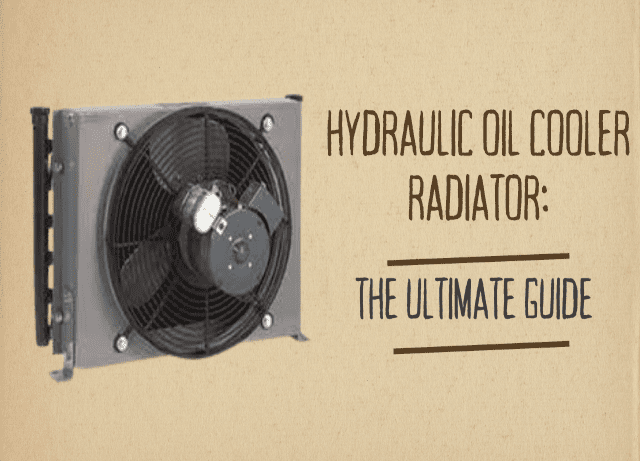What is a Hydraulic Oil Cooler Radiator?
A hydraulic oil cooler radiator is a device that helps regulate the temperature of hydraulic fluid in machinery. When hydraulic fluid gets too hot, it can break down, causing damage to the machinery. A hydraulic oil cooler radiator works by circulating fluid through a series of fins, which helps dissipate heat and regulate the fluid’s temperature.
Why Do You Need a Hydraulic Oil Cooler Radiator?
Using a hydraulic oil cooler radiator can provide a number of benefits, including:
- Extended equipment life: When hydraulic fluid gets too hot, it can cause damage to the machinery, shortening its lifespan. By using a hydraulic oil cooler radiator, you can help prevent this damage and extend the life of your equipment.
- Increased efficiency: When machinery gets too hot, it can become less efficient. By keeping the hydraulic fluid at a consistent temperature, you can help ensure that your equipment is running at peak efficiency.
- Improved safety: When hydraulic fluid gets too hot, it can become a fire hazard. By using a hydraulic oil cooler radiator, you can help reduce the risk of fire and keep your workplace safer.
How to Choose the Right Hydraulic Oil Cooler Radiator
When choosing a hydraulic oil cooler radiator, there are several factors to consider, including:
- Size: The size of the hydraulic oil cooler radiator should be appropriate for the size of the machinery it will be used with. Choosing the wrong size can lead to insufficient cooling or unnecessary expenses.
- Material: Hydraulic oil cooler radiators can be made from a variety of materials, including aluminum, copper, and steel. Each material has its own advantages and disadvantages, so it’s important to choose the material that is best suited for your needs.
- Type: There are several types of hydraulic oil cooler radiators, including air-cooled and liquid-cooled. Each type has its own benefits, so it’s important to choose the type that is best suited for your needs.
- Flow rate: The flow rate of the hydraulic oil cooler radiator should be appropriate for the amount of hydraulic fluid that will be flowing through it. Choosing the wrong flow rate can lead to insufficient cooling or unnecessary expenses.
At [Your Company Name], we can help you choose the right hydraulic oil cooler radiator for your needs. Our team of experts can help you determine the appropriate size, material, type, and flow rate for your machinery.
Maintenance and Care
To ensure that your hydraulic oil cooler radiator is working properly, it’s important to perform regular maintenance and care. This includes:
- Cleaning: Regularly cleaning the hydraulic oil cooler radiator can help remove dirt and debris that can interfere with its performance.
- Inspection: Regularly inspecting the hydraulic oil cooler radiator can help identify any issues before they become more serious.
- Replacement: Over time, hydraulic oil cooler radiators can become less effective. It’s important to replace them when necessary to ensure optimal performance.
Conclusion
A hydraulic oil cooler radiator is an important component of any machinery that uses hydraulic fluid. By choosing the right hydraulic oil cooler radiator and performing regular maintenance and care, you can help extend the life of your equipment, increase efficiency, and improve safety.
At [Your Company Name], we are committed to helping you find the right hydraulic oil cooler radiator for your needs. Contact us today to learn more about our products and services.
FAQs
What is a hydraulic oil cooler radiator?
A hydraulic oil cooler radiator is a device used to cool hydraulic fluid in hydraulic systems. It is designed to dissipate heat from the hydraulic system and maintain optimal operating temperatures.
Why is it important to use a hydraulic oil cooler radiator?
Using a hydraulic oil cooler radiator is important to prevent overheating of the hydraulic system, which can cause damage to the components and reduce the lifespan of the system. It also helps to improve the efficiency and performance of the system by maintaining optimal operating temperatures.
How does a hydraulic oil cooler radiator work?
A hydraulic oil cooler radiator works by circulating hydraulic fluid through a heat exchanger that dissipates heat to the surrounding air. The heat exchanger typically consists of a series of tubes or fins that increase the surface area for heat transfer. As the hydraulic fluid passes through the heat exchanger, it is cooled and returned to the hydraulic system.
What are the different types of hydraulic oil cooler radiators?
There are several types of hydraulic oil cooler radiators, including air-cooled, water-cooled, and oil-cooled. Air-cooled radiators are the most common and are typically used in applications where water is not available. Water-cooled radiators use water as a coolant and are more efficient than air-cooled radiators. Oil-cooled radiators use oil as a coolant and are typically used in high-temperature applications.
How do I choose the right hydraulic oil cooler radiator for my application?
Choosing the right hydraulic oil cooler radiator depends on several factors, including the operating temperature range of the hydraulic system, the size and flow rate of the hydraulic system, and the available space for the radiator. It is important to consult with a hydraulic system expert or the manufacturer to ensure that the correct radiator is selected for your application.
How do I maintain my hydraulic oil cooler radiator?
Maintaining your hydraulic oil cooler radiator involves regular cleaning and inspection to ensure that it is free from debris and damage. It is also important to check the fluid levels and pressure regularly and to replace any damaged components as necessary. Consult the manufacturer’s guidelines for specific maintenance recommendations.
What are some common problems with hydraulic oil cooler radiators?
Common problems with hydraulic oil cooler radiators include leaks, clogs, and damage to the fins or tubes. These issues can cause reduced efficiency or failure of the radiator. It is important to address any problems with the radiator promptly to prevent damage to the hydraulic system.










